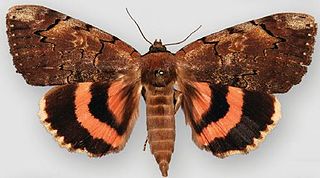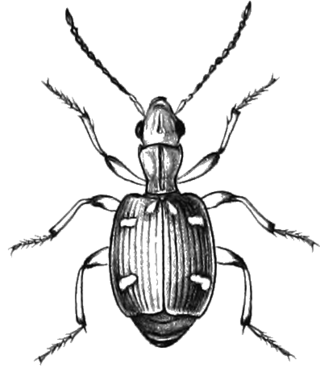"Carissima" is the alma mater of Hamilton College, words and music by M. W. Stryker in 1872.

The mastoid lymph nodes are a small group of lymph nodes, usually two in number, located just beneath the ear, on the mastoid insertion of the sternocleidomastoideus muscle, beneath the posterior auricular muscle.

Catocala cara, the darling underwing, is an moth of the family Erebidae. The species was first described by Achille Guenée in 1852. It can be found in the United States east of the Rocky Mountains; it occurs west at least to Oklahoma and north at least to Illinois. It also ranges into southern Canada, but only barely so.
"Carissima" is a piece for small orchestra by the English composer Sir Edward Elgar.

Catocala carissima, the carissima underwing, is a moth of the family Erebidae. The species can be found from Florida through Georgia to Texas.

Mastax is a genus of beetles in the family Carabidae, containing the following 52 species:
Avitomyrmex is an extinct genus of bulldog ants in the subfamily Myrmeciinae which contains three described species. The genus was described in 2006 from Ypresian stage deposits of British Columbia, Canada. Almost all the specimens collected are queens, with an exception of a single fossilised worker. These ants are large, and the eyes are also large and well developed; a sting is present in one species. The behaviour of these ants may have been similar to extant Myrmeciinae ants, such as foraging solitarily for arthropod prey and never leaving pheromone trails to food sources. Avitomyrmex has not been assigned to any tribe, instead generally being regarded as incertae sedis within Myrmeciinae. However, its identity as an ant has been challenged, although it is undoubtedly a hymenopteran insect.
Mastax fulvonotata is a species of beetle in the family Carabidae with restricted distribution in the India.
Mastax congoensis is a species of beetle in the family Carabidae with restricted distribution in the Afghanistan.
Mastax liebkei is a species of beetle in the family Carabidae with restricted distribution in the Democratic Republic of Congo.
Mastax louwerensi is a species of beetle in the family Carabidae with restricted distribution in the Indonesia.
Mastax pakistana is a species of beetle in the family Carabidae with restricted distribution in the Pakistan.
Mastax philippina is a species of beetle in the family Carabidae with restricted distribution in the Philippines.
Mastax raffrayi is a species of beetle in the family Carabidae with restricted distribution in the Ethiopia.
Mastax rawalpindi is a species of beetle in the family Carabidae with restricted distribution in the Pakistan.
Mastax nana is a species of beetle in the family Carabidae found in Chad, Mali and Democratic Republic of the Congo.
Mastax poecila is a species of beetle in the family Carabidae found in Cambodia, China and Singapore.
Mastax royi is a species of beetle in the family Carabidae that can be found in Ivory Coast and Senegal.

Cremnosterna carissima is a species of beetle in the family Cerambycidae. It was described by Francis Polkinghorne Pascoe in 1857. It is known from India, Myanmar, Cambodia, Laos, Thailand, Vietnam and Nepal.
Carissima is a Venezuelan telenovela written by Julio César Mármol and produced by RCTV in 2001. The telenovela lasted 103 episodes and was distributed internationally by RCTV International.




